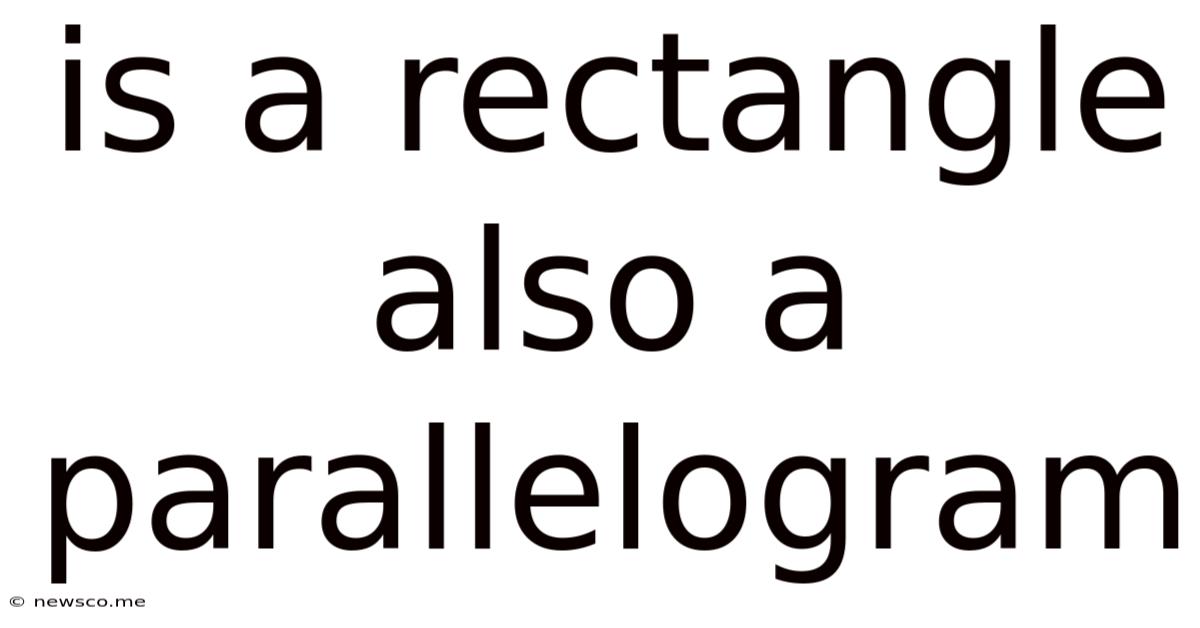Is A Rectangle Also A Parallelogram
News Co
May 08, 2025 · 5 min read

Table of Contents
Is a Rectangle Also a Parallelogram? A Deep Dive into Quadrilateral Geometry
Understanding the relationships between different geometric shapes is fundamental to grasping core concepts in geometry. This article delves into the fascinating question: is a rectangle also a parallelogram? We'll explore the defining characteristics of both shapes, examining their properties and proving conclusively whether a rectangle fits the definition of a parallelogram. We’ll also explore related quadrilaterals and their properties to gain a broader understanding of geometric classifications.
Defining Key Terms: Parallelograms and Rectangles
Before we can determine if a rectangle is a parallelogram, we need clear definitions of both shapes.
What is a Parallelogram?
A parallelogram is a quadrilateral (a four-sided polygon) with two pairs of parallel sides. This is its defining characteristic. Other properties emerge from this fundamental property, including:
- Opposite sides are congruent (equal in length). Since the sides are parallel, and we can form congruent triangles by drawing a diagonal across the parallelogram, opposite sides must be equal.
- Opposite angles are congruent. This follows directly from the congruent triangles formed by the diagonals.
- Consecutive angles are supplementary (add up to 180 degrees). Because parallel lines intersected by a transversal create supplementary angles, consecutive angles in a parallelogram sum to 180 degrees.
- Diagonals bisect each other. This means the diagonals intersect at a point that divides each diagonal into two equal segments.
What is a Rectangle?
A rectangle is also a quadrilateral, but its defining characteristic is that it possesses four right angles (90-degree angles). Like parallelograms, rectangles also exhibit other properties derived from their definition:
- Opposite sides are parallel. The right angles ensure that opposite sides are parallel.
- Opposite sides are congruent. The parallel and equal-length sides make this possible.
- Diagonals are congruent (equal in length). This unique property distinguishes rectangles from other parallelograms. The diagonals bisect each other, but also have identical lengths.
Proving the Relationship: Is a Rectangle a Parallelogram?
Given the definitions above, it becomes clear that a rectangle is indeed a parallelogram. A rectangle satisfies the defining characteristic of a parallelogram: it has two pairs of parallel sides. The presence of four right angles inherently guarantees that opposite sides are parallel.
Therefore, a rectangle can be considered a special case of a parallelogram. It inherits all the properties of a parallelogram but also possesses the additional property of having four right angles and congruent diagonals.
Exploring Other Quadrilaterals and Their Relationships
To further solidify our understanding, let's briefly explore other quadrilaterals and their relationships to parallelograms and rectangles:
Squares
A square is a quadrilateral that is both a rectangle and a rhombus. This means it has all the properties of a rectangle (four right angles, opposite sides parallel and congruent, congruent diagonals) and all the properties of a rhombus (all sides congruent, diagonals bisect each other at right angles). Therefore, a square is a special case of both rectangles and parallelograms.
Rhombuses
A rhombus is a parallelogram with all four sides congruent. While it shares the parallel sides property of a parallelogram, it doesn't necessarily have right angles. Thus, a rhombus is a parallelogram, but not necessarily a rectangle.
Trapezoids
A trapezoid (or trapezium) is a quadrilateral with at least one pair of parallel sides. Unlike parallelograms, rectangles, and squares, trapezoids do not necessarily have two pairs of parallel sides. Therefore, a trapezoid is not a parallelogram. An isosceles trapezoid has congruent legs (non-parallel sides) and congruent base angles.
Real-World Applications and Examples
Understanding the relationship between rectangles and parallelograms has practical applications in various fields:
- Architecture and Construction: Rectangles are fundamental in building design, from window frames and doorways to the overall structure of buildings. The properties of parallelograms (and rectangles) ensure structural stability and predictable dimensions.
- Engineering: In engineering, understanding geometric properties is crucial for designing stable and efficient structures. The principles governing parallelograms are applied in bridge construction, mechanical systems, and many other areas.
- Computer Graphics and Design: The properties of rectangles and other quadrilaterals are essential for creating and manipulating shapes in computer graphics and design software.
Expanding the Understanding: Further Exploration
While this article clarifies the relationship between rectangles and parallelograms, further exploration can deepen your understanding of geometric concepts:
- Coordinate Geometry: Representing and analyzing these shapes using coordinate systems provides a powerful tool for solving problems and proving geometric theorems.
- Vector Geometry: Using vectors to represent sides and diagonals offers another perspective on the properties of parallelograms and rectangles.
- Trigonometry: Trigonometric functions can be used to calculate angles, side lengths, and areas of these shapes.
By delving into these advanced techniques, you can achieve a comprehensive grasp of the properties and relationships between various geometric shapes, significantly enhancing your mathematical skills.
Conclusion: Rectangles are a Specialized Type of Parallelogram
To reiterate the central point: yes, a rectangle is a parallelogram. It inherits all the properties of a parallelogram while possessing the additional characteristics of four right angles and congruent diagonals. This understanding forms a cornerstone for further exploration into the fascinating world of geometry and its practical applications. The hierarchical relationship between these shapes helps us categorize and understand their unique attributes within the broader context of quadrilateral geometry. Remember, a square is a special case of both a rectangle and a rhombus, highlighting the interconnectedness of geometric forms and their defining properties. This rich interrelationship is a testament to the elegance and power of geometric principles.
Latest Posts
Related Post
Thank you for visiting our website which covers about Is A Rectangle Also A Parallelogram . We hope the information provided has been useful to you. Feel free to contact us if you have any questions or need further assistance. See you next time and don't miss to bookmark.